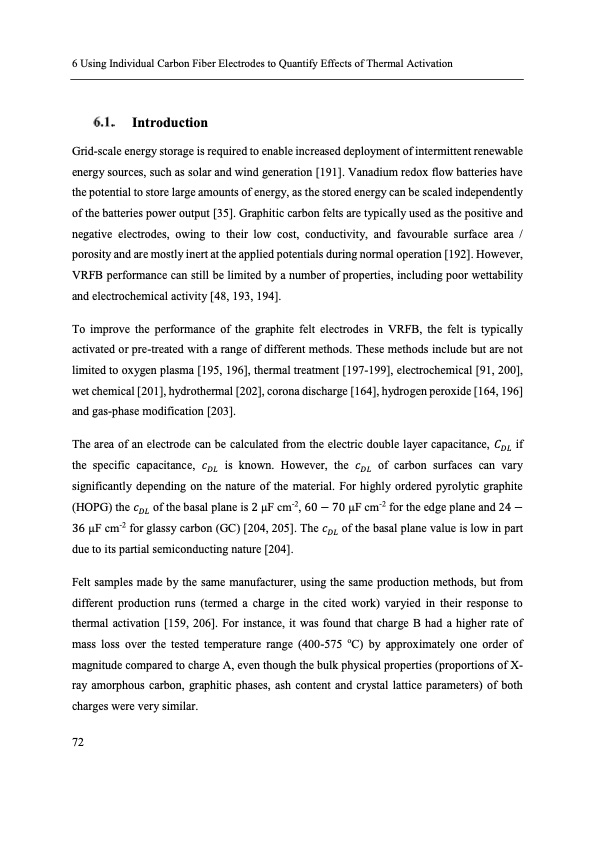
PDF Publication Title:
Text from PDF Page: 084
6 Using Individual Carbon Fiber Electrodes to Quantify Effects of Thermal Activation Introduction Grid-scale energy storage is required to enable increased deployment of intermittent renewable energy sources, such as solar and wind generation [191]. Vanadium redox flow batteries have the potential to store large amounts of energy, as the stored energy can be scaled independently of the batteries power output [35]. Graphitic carbon felts are typically used as the positive and negative electrodes, owing to their low cost, conductivity, and favourable surface area / porosity and are mostly inert at the applied potentials during normal operation [192]. However, VRFB performance can still be limited by a number of properties, including poor wettability and electrochemical activity [48, 193, 194]. To improve the performance of the graphite felt electrodes in VRFB, the felt is typically activated or pre-treated with a range of different methods. These methods include but are not limited to oxygen plasma [195, 196], thermal treatment [197-199], electrochemical [91, 200], wet chemical [201], hydrothermal [202], corona discharge [164], hydrogen peroxide [164, 196] and gas-phase modification [203]. The area of an electrode can be calculated from the electric double layer capacitance, 𝐶𝐷𝐿 if the specific capacitance, 𝑐𝐷𝐿 is known. However, the 𝑐𝐷𝐿 of carbon surfaces can vary significantly depending on the nature of the material. For highly ordered pyrolytic graphite (HOPG) the 𝑐𝐷𝐿 of the basal plane is 2 μF cm-2, 60 − 70 μF cm-2 for the edge plane and 24 − 36 μF cm-2 for glassy carbon (GC) [204, 205]. The 𝑐𝐷𝐿 of the basal plane value is low in part due to its partial semiconducting nature [204]. Felt samples made by the same manufacturer, using the same production methods, but from different production runs (termed a charge in the cited work) varyied in their response to thermal activation [159, 206]. For instance, it was found that charge B had a higher rate of mass loss over the tested temperature range (400-575 oC) by approximately one order of magnitude compared to charge A, even though the bulk physical properties (proportions of X- ray amorphous carbon, graphitic phases, ash content and crystal lattice parameters) of both charges were very similar. 72PDF Image | Electron Transfer Kinetics in Redox Flow Batteries

PDF Search Title:
Electron Transfer Kinetics in Redox Flow BatteriesOriginal File Name Searched:
electron-transfer-flow-batteries-thesis.pdfDIY PDF Search: Google It | Yahoo | Bing
Salgenx Redox Flow Battery Technology: Salt water flow battery technology with low cost and great energy density that can be used for power storage and thermal storage. Let us de-risk your production using our license. Our aqueous flow battery is less cost than Tesla Megapack and available faster. Redox flow battery. No membrane needed like with Vanadium, or Bromine. Salgenx flow battery
| CONTACT TEL: 608-238-6001 Email: greg@salgenx.com | RSS | AMP |